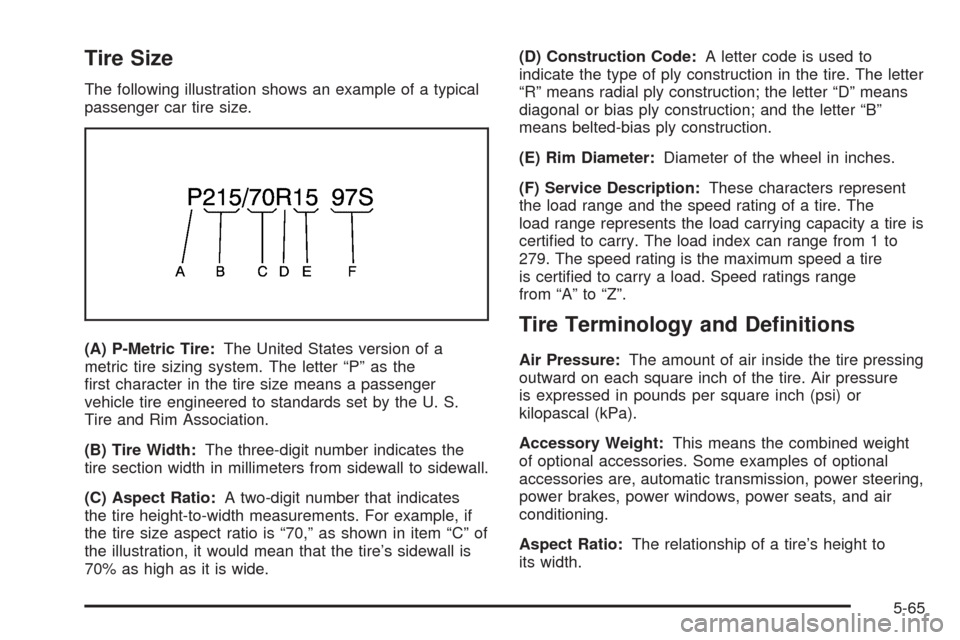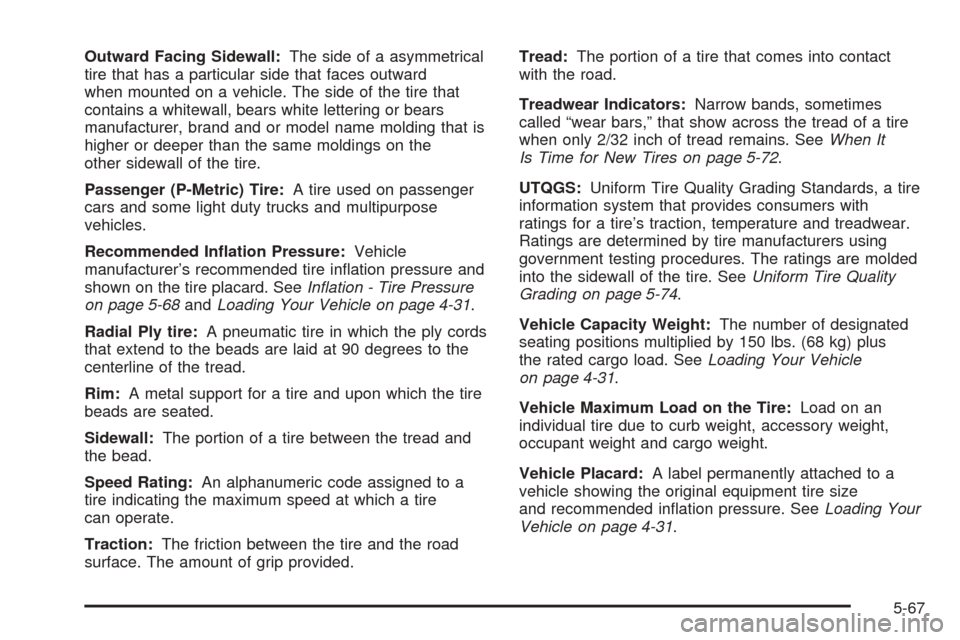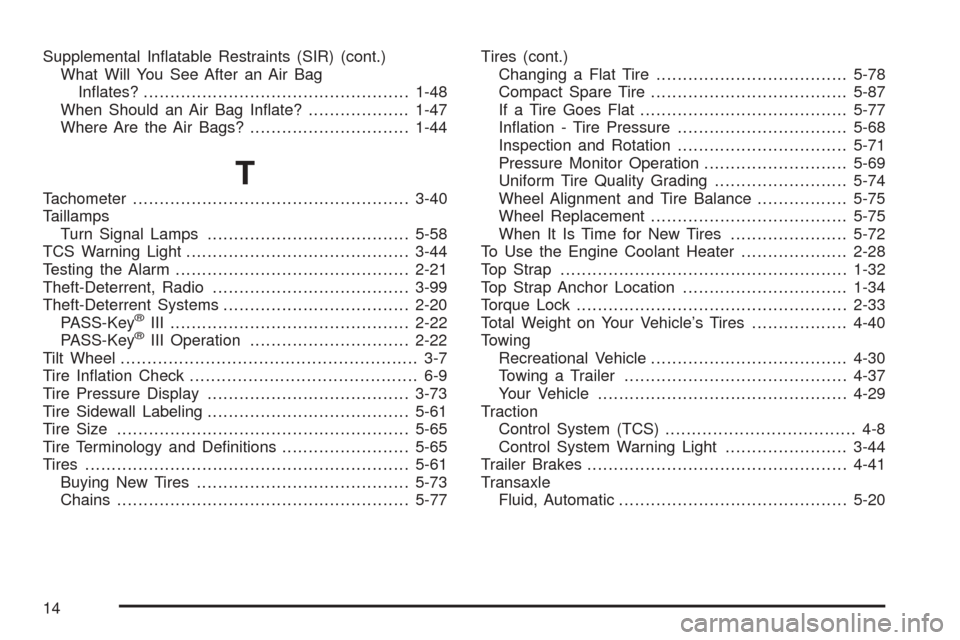2004 CADILLAC SEVILLE weight
[x] Cancel search: weightPage 325 of 410

Tire Size
The following illustration shows an example of a typical
passenger car tire size.
(A) P-Metric Tire:The United States version of a
metric tire sizing system. The letter “P” as the
first character in the tire size means a passenger
vehicle tire engineered to standards set by the U. S.
Tire and Rim Association.
(B) Tire Width:The three-digit number indicates the
tire section width in millimeters from sidewall to sidewall.
(C) Aspect Ratio:A two-digit number that indicates
the tire height-to-width measurements. For example, if
the tire size aspect ratio is “70,” as shown in item “C” of
the illustration, it would mean that the tire’s sidewall is
70% as high as it is wide.(D) Construction Code:A letter code is used to
indicate the type of ply construction in the tire. The letter
“R” means radial ply construction; the letter “D” means
diagonal or bias ply construction; and the letter “B”
means belted-bias ply construction.
(E) Rim Diameter:Diameter of the wheel in inches.
(F) Service Description:These characters represent
the load range and the speed rating of a tire. The
load range represents the load carrying capacity a tire is
certified to carry. The load index can range from 1 to
279. The speed rating is the maximum speed a tire
is certified to carry a load. Speed ratings range
from “A” to “Z”.
Tire Terminology and Definitions
Air Pressure:The amount of air inside the tire pressing
outward on each square inch of the tire. Air pressure
is expressed in pounds per square inch (psi) or
kilopascal (kPa).
Accessory Weight:This means the combined weight
of optional accessories. Some examples of optional
accessories are, automatic transmission, power steering,
power brakes, power windows, power seats, and air
conditioning.
Aspect Ratio:The relationship of a tire’s height to
its width.
5-65
Page 326 of 410

Belt:A rubber coated layer of cords that is located
between the plies and the tread. Cords may be made
from steel or other reinforcing materials.
Bead:The tire bead contains steel wires wrapped by
steel cords that hold the tire onto the rim.
Bias Ply Tire:A pneumatic tire in which the plies are
laid at alternate angles less than 90 degrees to the
centerline of the tread.
Cold Inflation Pressure:The amount of air pressure in
a tire, measured in pounds per square inch (psi)
before a tire has built up heat from driving. See
In�ation - Tire Pressure on page 5-68.
Curb Weight:This means the weight of a motor
vehicle with standard and optional equipment including
the maximum capacity of fuel, oil and coolant, but
without passengers and cargo.
DOT Markings:A code molded into the sidewall of a
tire signifying that the tire is in compliance with the U.S.
Department of Transportation motor vehicle safety
standards. The DOT code includes the Tire Identification
Number (TIN), an alphanumeric designator which can
also identify the tire manufacturer, production plant,
brand and date of production.
GVWR:Gross Vehicle Weight Rating, seeLoading
Your Vehicle on page 4-31.
GAWR FRT:Gross Axle Weight Rating for the front
axle, seeLoading Your Vehicle on page 4-31.GAWR RR:Gross Axle Weight Rating for the rear axle,
seeLoading Your Vehicle on page 4-31.
Intended Outboard Sidewall:The side of an
asymmetrical tire that must always face outward when
mounted on a vehicle.
Kilopascal (kPa):The metric unit for air pressure.
There are 6.9 kPa’s to one psi.
Light Truck (LT-Metric) Tire:A tire used on light duty
trucks and some multipurpose passenger vehicles.
Load Index:An assigned number ranging from 1 to 279
that corresponds to the load carrying capacity of
a tire.
Maximum Inflation Pressure:The maximum air
pressure to which a cold tire may be inflated. The
maximum air pressure is molded onto the sidewall.
Maximum Load Rating:The load rating for a tire at the
maximum permissible inflation pressure for that tire.
Maximum Loaded Vehicle Weight:The sum of curb
weight; accessory weight; vehicle capacity weight;
and production options weight.
Normal Occupant Weight:The number of occupants a
vehicle is designed to seat multiplied by 150 pounds
(68 kg). SeeLoading Your Vehicle on page 4-31.
Occupant Distribution:Designated seating positions.
5-66
Page 327 of 410

Outward Facing Sidewall:The side of a asymmetrical
tire that has a particular side that faces outward
when mounted on a vehicle. The side of the tire that
contains a whitewall, bears white lettering or bears
manufacturer, brand and or model name molding that is
higher or deeper than the same moldings on the
other sidewall of the tire.
Passenger (P-Metric) Tire:A tire used on passenger
cars and some light duty trucks and multipurpose
vehicles.
Recommended Inflation Pressure:Vehicle
manufacturer’s recommended tire inflation pressure and
shown on the tire placard. SeeIn�ation - Tire Pressure
on page 5-68andLoading Your Vehicle on page 4-31.
Radial Ply tire:A pneumatic tire in which the ply cords
that extend to the beads are laid at 90 degrees to the
centerline of the tread.
Rim:A metal support for a tire and upon which the tire
beads are seated.
Sidewall:The portion of a tire between the tread and
the bead.
Speed Rating:An alphanumeric code assigned to a
tire indicating the maximum speed at which a tire
can operate.
Traction:The friction between the tire and the road
surface. The amount of grip provided.Tread:The portion of a tire that comes into contact
with the road.
Treadwear Indicators:Narrow bands, sometimes
called “wear bars,” that show across the tread of a tire
when only 2/32 inch of tread remains. SeeWhen It
Is Time for New Tires on page 5-72.
UTQGS:Uniform Tire Quality Grading Standards, a tire
information system that provides consumers with
ratings for a tire’s traction, temperature and treadwear.
Ratings are determined by tire manufacturers using
government testing procedures. The ratings are molded
into the sidewall of the tire. SeeUniform Tire Quality
Grading on page 5-74.
Vehicle Capacity Weight:The number of designated
seating positions multiplied by 150 lbs. (68 kg) plus
the rated cargo load. SeeLoading Your Vehicle
on page 4-31.
Vehicle Maximum Load on the Tire:Load on an
individual tire due to curb weight, accessory weight,
occupant weight and cargo weight.
Vehicle Placard:A label permanently attached to a
vehicle showing the original equipment tire size
and recommended inflation pressure. SeeLoading Your
Vehicle on page 4-31.
5-67
Page 408 of 410

Supplemental Inflatable Restraints (SIR) (cont.)
What Will You See After an Air Bag
Inflates?..................................................1-48
When Should an Air Bag Inflate?...................1-47
Where Are the Air Bags?..............................1-44
T
Tachometer....................................................3-40
Taillamps
Turn Signal Lamps......................................5-58
TCS Warning Light..........................................3-44
Testing the Alarm............................................2-21
Theft-Deterrent, Radio.....................................3-99
Theft-Deterrent Systems...................................2-20
PASS-Key
®III .............................................2-22
PASS-Key®III Operation..............................2-22
Tilt Wheel........................................................ 3-7
Tire Inflation Check........................................... 6-9
Tire Pressure Display......................................3-73
Tire Sidewall Labeling......................................5-61
Tire Size.......................................................5-65
Tire Terminology and Definitions........................5-65
Tires.............................................................5-61
Buying New Tires........................................5-73
Chains.......................................................5-77Tires (cont.)
Changing a Flat Tire....................................5-78
Compact Spare Tire.....................................5-87
If a Tire Goes Flat.......................................5-77
Inflation - Tire Pressure................................5-68
Inspection and Rotation................................5-71
Pressure Monitor Operation...........................5-69
Uniform Tire Quality Grading.........................5-74
Wheel Alignment and Tire Balance.................5-75
Wheel Replacement.....................................5-75
When It Is Time for New Tires......................5-72
To Use the Engine Coolant Heater....................2-28
Top Strap......................................................1-32
Top Strap Anchor Location...............................1-34
Torque Lock...................................................2-33
Total Weight on Your Vehicle’s Tires..................4-40
Towing
Recreational Vehicle.....................................4-30
Towing a Trailer..........................................4-37
Your Vehicle...............................................4-29
Traction
Control System (TCS).................................... 4-8
Control System Warning Light.......................3-44
Trailer Brakes.................................................4-41
Transaxle
Fluid, Automatic...........................................5-20
14
Page 410 of 410

W
Warning Lights, Gages and Indicators................3-37
Warnings
DIC Warnings and Messages........................3-55
Hazard Warning Flashers............................... 3-6
Other Warning Devices.................................. 3-7
Safety and Symbols......................................... iii
Vehicle Damage.............................................. iv
Washing Your Vehicle......................................5-90
Weather Band..............................................3-101
Weight of the Trailer........................................4-38
Weight of the Trailer Tongue.............................4-39
What Kind of Engine Oil to Use........................5-14
What to Do with Used Oil................................5-17
What to Use..................................5-24, 5-36, 5-37
Wheels
Alignment and Tire Balance..........................5-75
Replacement...............................................5-75
When to Add Engine Oil..................................5-14
When to Change Engine Oil
(GM Oil Life System)...................................5-16
When to Check..............................................5-68
When to Check and Change............................5-20
When to Check Power Steering Fluid................5-36
When You Are Ready to Leave
After Parking on a Hill:.................................4-44Where to Put the Restraint...............................1-32
Why Safety Belts Work..................................... 1-6
Window Lockout.............................................2-19
Windows.......................................................2-16
Power........................................................2-17
Windshield Washer.........................................3-13
Fluid..........................................................5-37
Windshield Wiper
Blade Replacement......................................5-60
Fuses........................................................5-96
Windshield Wipers..........................................3-11
Winter Driving................................................4-24
Wiper-Activated Headlamps..............................3-17
X
XM™ Satellite Radio Antenna System..............3-103
XM™ Satellite Radio Service
(48 Contiguous US States)..........3-76, 3-83, 3-100
Y
Your Vehicle and the Environment....................... 6-2
16